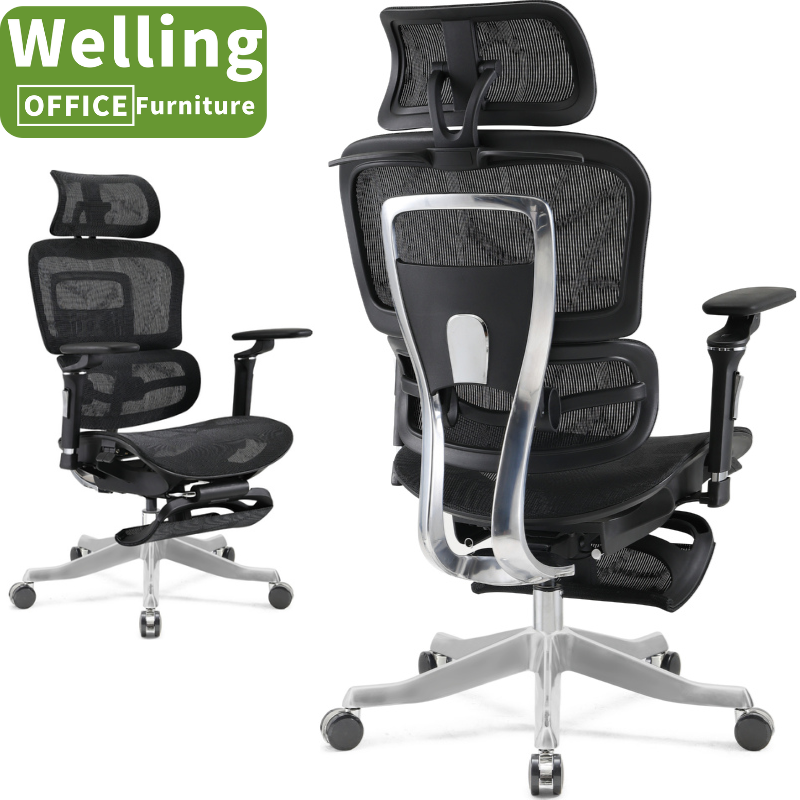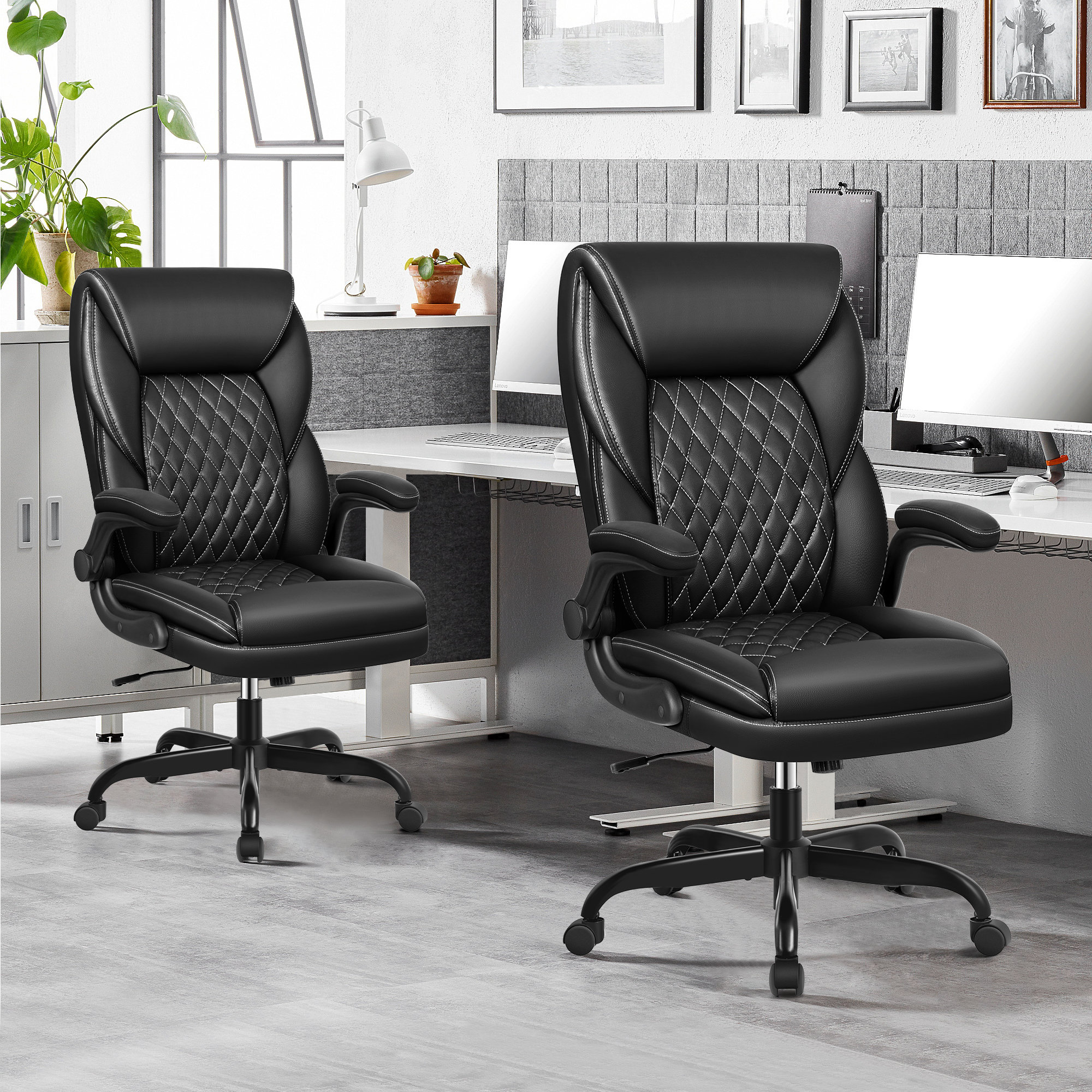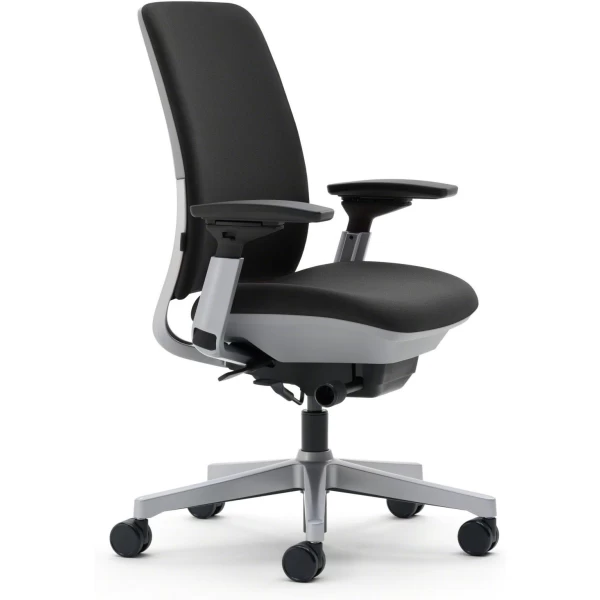Learn the Vital Attributes of an Ergonomic Workplace Chair That You Need To Take into consideration
Selecting the ideal ergonomic workplace chair is essential for anyone costs long hours at a desk. Key attributes such as adjustable seat height, lumbar assistance, and armrest adjustability can significantly affect comfort and pose. Ergonomic Office Chair. Understanding the value of seat depth and material quality additionally plays an essential duty in total satisfaction. However, several overlook various other vital elements. What extra factors should be thought about to guarantee peak efficiency and well-being in the work space?
Adjustable Seat Elevation
When selecting an ergonomic office chair, adjustable seat height is an important attribute that greatly boosts comfort and use. This characteristic allows customers to customize the chair's elevation to their individual requirements, guaranteeing that their feet rest level on the floor while their knees stay at a 90-degree angle. Appropriate seat height adds to perfect stance, lowering stress on the legs and reduced back throughout prolonged durations of resting.
Flexible seat height suits a varied range of body types and desk arrangements, making it a functional choice for both home and workplace settings. The simplicity of change normally includes an easy bar device, allowing users to change the elevation with minimal effort. This feature is particularly advantageous in shared work spaces, where multiple individuals might make use of the very same chair. Ultimately, purchasing an ergonomic workplace chair with flexible seat height is important for advertising general health and productivity in the workplace.
Lumbar Support
Back support is a crucial feature in ergonomic workplace chairs, as it assists maintain the natural contour of the spine and reduces the risk of back discomfort. Flexible lumbar assistance permits users to customize the degree of assistance according to their specific demands, promoting much better position throughout the day. This flexibility not only boosts comfort but additionally contributes to overall productivity and health.
Importance of Lumbar Support
Proper back assistance is crucial for keeping a healthy and balanced pose during lengthy hours of resting. The back region of the spine is naturally curved, and without ample support, this curve can squash, resulting in discomfort and strain. Not enough lumbar support can cause a selection of problems, including lower back pain, muscular tissue fatigue, and decreased efficiency. When a workplace chair supplies proper back support, it helps to line up the spinal column, reducing the chance of establishing musculoskeletal problems. This assistance urges the customer to unwind in the chair, promoting engagement of the core muscular tissues and boosting overall comfort. Picking an ergonomic chair with ideal lumbar assistance is important for individuals that spend expanded durations at their workdesks.
Adjustable Lumbar Qualities
Adjustable lumbar attributes are vital in improving the performance of office chairs created for prolonged resting. These attributes enable customers to tailor the elevation, deepness, and firmness of the back support to align with their special spinal contours. Proper lumbar support mitigates pain and advertises healthy stance, decreasing the danger of neck and back pain connected with extended desk job. When picking a workplace chair, it is necessary to try to find alternatives that supply very easy adjustments, allowing customers to locate their ideal assistance degree. Furthermore, some chairs include memory foam or breathable materials, improving comfort throughout lengthy hours. On the whole, flexible lumbar attributes considerably add to a more ergonomic office, cultivating efficiency and well-being among customers.
Seat Deepness and Width
Seat depth and size are necessary consider figuring out the general comfort of an ergonomic office chair. Correct dimensions can significantly influence a person's posture, making adjustability vital for fitting various physique. Making certain optimal seat measurements permits individuals to preserve a healthy seating setting throughout their day.
Optimal Seat Measurements

Finding the ideal equilibrium in seat measurements is vital for convenience and support in an ergonomic workplace chair. A suitable seat width normally ranges from 18 to 22 inches, suiting different type of body while maintaining convenience of motion. Seat deepness is just as important, with a suggested deepness of 16 to 18 inches, allowing individuals to rest comfortably without feeling limited. Proper seat dimensions ensure that the upper legs are sufficiently supported while leaving a small space in between the rear of the knees and the seat edge, promoting flow. In addition, the seat should allow users to preserve an all-natural posture, minimizing the threat of pressure. Generally, selecting the best seat dimensions is essential for enhancing productivity and health throughout lengthy hours of resting.

Adjustability for Comfort
While convenience is paramount in an ergonomic office chair, the ability to change seat depth and width plays a vital function in accommodating specific preferences and type of body. Seat depth changes permit users to place themselves effectively, making sure that their backs are sustained while you could try here giving sufficient space for their legs. A seat that is unfathomable might result in discomfort at the knees, while one that is too superficial can lead to inadequate assistance. In a similar way, adjustable click here for more info seat size assists cater to various body dimensions, promoting a more personalized seating experience. By allowing customers to customize these dimensions, ergonomic chairs boost general convenience, allowing much longer, much more effective job sessions without unnecessary strain.
Influence on Position
Proper seat depth and size significantly affect stance, as they directly impact exactly how a user straightens their body while seated. A suitable seat deepness allows the thighs to rest completely on the chair without too much pressure at the back of the knees, promoting flow and convenience. If the seat is unfathomable, it can lead to slouching, while a seat that is as well superficial may not supply sufficient support. The size of the seat should fit the individual conveniently, enabling for all-natural arm positioning without limitation. A chair that sustains a neutral spinal column placement encourages better pose, lowering stress on the back and neck. Choosing the ideal seat measurements is critical for preserving healthy and balanced posture during extended resting.
Armrest Adjustability
Armrest adjustability plays a vital role in improving customer convenience and assistance throughout extended periods of resting. Ergonomic office chairs typically include armrests that can be moved in various directions-- backwards and forwards, side to side, and even pivoted. This flexibility enables customers to discover the ideal height and angle, reducing pressure on the shoulders and neck. Appropriate armrest positioning can also minimize pressure on the wrists, promoting far better hand positioning when inputting or using a mouse. Additionally, flexible armrests fit various type of body and personal preferences, guaranteeing that each individual can attain a personalized fit. Taken care of armrests might result in discomfort and tiredness, especially during extended usage, whereas flexible options provide the flexibility needed for vibrant workplace. Consequently, when selecting an ergonomic office chair, taking into consideration armrest adjustability is essential for general comfort and productivity at job.

Back-rest Recline and Turn
Backrest recline and tilt attributes considerably add to an ergonomic workplace chair's overall assistance and convenience (Ergonomic Office Chair). These devices enable users to readjust the angle of news the backrest, providing perfect back alignment and decreasing stress on the lower back. A chair with an appropriate recline function enables people to change their position throughout the day, promoting better blood circulation and lowering tiredness
Moreover, the tilt attribute encourages dynamic movement, allowing individuals to engage their core muscular tissues while seated. This flexibility is necessary for preserving focus and productivity during lengthy hours of work. Chairs that supply a wide variety of recline angles provide to various choices, accommodating both upright seating for jobs and an extra kicked back placement for breaks.
Material and Develop Quality
The selection of material and construct quality is necessary in determining the durability and convenience of an ergonomic office chair. Top notch products, such as breathable mesh or sturdy material, boost ventilation, supplying a comfy seating experience throughout long hours of use. The framework needs to ideally be built from robust materials like steel or enhanced plastic, making certain security and assistance.
In addition, the high quality of foam made use of in cushioning significantly affects comfort levels; memory foam adapts to body contours, offering personalized assistance while lowering pressure points. An ergonomic chair needs to also include a well-designed structure that permits modifications, ensuring that users can customize the fit to their specific needs.
The build high quality needs to include durable casters and a trusted gas lift system for smooth elevation modifications. Purchasing a chair with premium products and construct top quality inevitably adds to better posture, productivity, and total well-being in the workplace.
Regularly Asked Concerns
How Do I Choose the Right Chair for My Physique?
To pick the appropriate chair for one's type of body, one should assess seat height, back support, seat deepness, and armrest positioning. Examining different versions warranties convenience and appropriate alignment, inevitably advertising much better posture and wellness.
Are Ergonomic Chairs Appropriate for Short or Tall People?
Ergonomic chairs can be appropriate for both short and tall individuals, supplied they provide adjustable attributes such as seat height, backrest, and armrests. This flexibility guarantees convenience and assistance for various body kinds and dimensions.
Can I Use an Ergonomic Chair With a Standing Workdesk?
Yes, an ergonomic chair can be used with a standing desk. It supplies versatility for alternating in between standing and resting, advertising far better pose and convenience throughout the workday, inevitably boosting efficiency and decreasing tiredness.
How Frequently Should I Change My Chair Settings?
Changing chair setups need to occur regularly, ideally every couple of hours or when experiencing discomfort. Frequent modifications advertise far better posture and convenience, enhancing efficiency and minimizing pressure during prolonged periods of resting. Consistency is essential for suitable comfort designs.
What Is the Average Lifespan of an Ergonomic Workplace Chair?
The ordinary life-span of an ergonomic office chair normally varies from 7 to ten years, depending upon usage, materials, and upkeep. Routine care can prolong its durability, making certain excellent assistance and comfort throughout its life.
When choosing an ergonomic office chair, adjustable seat height is an important attribute that substantially improves comfort and functionality. Seat deepness and width are important aspects in determining the general comfort of an ergonomic workplace chair. Locating the ideal equilibrium in seat dimensions is crucial for comfort and support in an ergonomic office chair. While convenience is extremely important in an ergonomic office chair, the capability to change seat depth and width plays an essential duty in accommodating specific preferences and body types. To choose the ideal chair for one's body type, one need to assess seat height, back support, seat deepness, and armrest positioning.